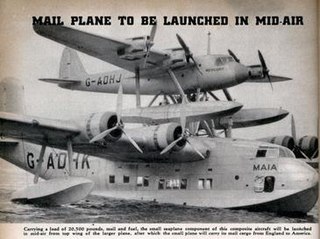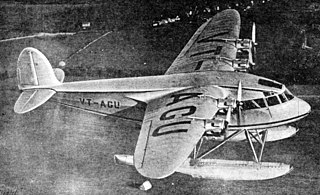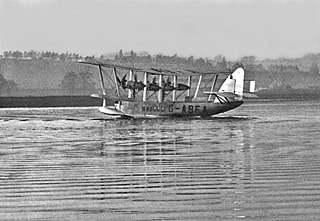Operational history
The S.8 Calcutta made its first flight on 14 February 1928, having been launched the previous day and left at its mooring overnight to assess the hull for signs of leakage. Shorts' Chief Test Pilot, John Lankester Parker was at the controls, with Major Herbert G. Brackley of Imperial Airways as co-pilot. On 15 March 1928, this aircraft (registered as G-EBVG) was delivered by Parker and Brackley to the Marine Aircraft Experimental Establishment, Felixstowe, for its airworthiness and sea handling checks; these were successfully completed on 27 July of the same year and the aircraft was flown back to Shorts on the same day. [1] G-EBVG was handed over to Imperial Airways on 9 August 1928. [2]
The S.8 Calcutta was introduced in 1928 and was used by Imperial Airways flying the Mediterranean-to-Karachi leg of the Britain-to-India route.
A total of seven aircraft were built. A military version of the Calcutta, originally known as the Calcutta (Service type), was built as the Short Rangoon . In 1924, a Calcutta was purchased by the French Breguet Company from which they developed a military version for the French Navy known as the Breguet S.8/2, which was similar to the Rangoon version. Four aircraft were built under licence by Breguet at Le Havre. Breguet later developed an improved version, the Breguet 521 Bizerte.
On 1 August 1928, Parker, accompanied by Oswald Short, flew G-EBVG to Westminster, setting it down on the Thames between Vauxhall and Lambeth Bridges; it was moored off the Albert Embankment for three days for inspection by Members of Parliament (including the then Chancellor of the Exchequer, Winston Churchill), members of the House of Lords and others. [1] [3]
Accidents and incidents
The City of Rome (registration G-AADN) made a forced landing in high winds and poor weather in the Ligurian Sea off La Spezia, Italy, during a scheduled passenger flight from Naples International Airport in Naples, Italy, to Genoa Cristoforo Colombo Airport outside Genoa, Italy, on 26 October 1929. It sank during efforts to tow it to shore, killing all seven people on board. [4]
The City of Khartoum (G-AASJ) suffered a catastrophic failure of all three engines shortly before the end of its flight between Crete and Alexandria, Egypt, just after nightfall on 31 December 1935. The pilot was the only survivor; nine passengers and three crew were killed either by the impact with water or by drowning when the aircraft was overwhelmed by heavy waves. An inquiry by the British Air Ministry found that the carburettors had been altered in a way which increased fuel consumption, resulting in the aircraft running out of fuel. [5]

Imperial Airways was an early British commercial long-range airline, operating from 1924 to 1939 and principally serving the British Empire routes to South Africa, India, Australia and the Far East, including Malaya and Hong Kong. Passengers were typically businessmen or colonial administrators, and most flights carried about 20 passengers or fewer. Accidents were frequent: in the first six years, 32 people died in seven incidents. Imperial Airways never achieved the levels of technological innovation of its competitors and was merged into the British Overseas Airways Corporation (BOAC) in 1939. BOAC in turn merged with the British European Airways (BEA) in 1974 to form British Airways.
Short Brothers plc, usually referred to as Shorts or Short, is an aerospace company based in Belfast, Northern Ireland. Shorts was founded in 1908 in London, and was the first company in the world to make production aeroplanes. It was particularly notable for its flying boat designs manufactured into the 1950s.

The Short Empire was a medium-range four-engined monoplane flying boat, designed and developed by Short Brothers during the 1930s to meet the requirements of the growing commercial airline sector, with a particular emphasis upon its usefulness upon the core routes that served the United Kingdom. It was developed and manufactured in parallel with the Short Sunderland maritime patrol bomber, which went on to serve in the Second World War; a further derivative that was later developed was the piggy-back Short Mayo Composite.

The Short S.25 Sandringham is a British civilian flying boat designed and originally produced by Short Brothers. They were produced as conversions of the widely used Short Sunderland, a military flying boat that was commonly used as a maritime patrol aircraft.

The Short Solent is a passenger flying boat that was produced by Short Brothers in the late 1940s. It was developed from the Short Seaford, itself a development of the Short Sunderland military flying boat design.

The Short S.14 Sarafand was a British biplane flying boat built by Short Brothers. It was planned as a general reconnaissance aircraft for military service. When it was built in 1932 it was the largest aeroplane in the United Kingdom.

The Short S.26 G-class was a large transport flying boat designed and produced by the British aircraft manufacturer Short Brothers. It was designed to achieve a non-stop transatlantic capability, increasing the viability of long distant services/duties.
The Short Shetland was a British high-speed, long-range, four-engined flying boat built by Short Brothers at Rochester, Kent for use in the Second World War. It was designed to meet an Air Ministry requirement for a very-long range reconnaissance flying boat. The design used the company's experience with large scale production of the Short Sunderland. The end of World War II prevented the Shetland from entering production. It was the first aircraft designed with a 110 volt electrical system.

The Short Mayo Composite was a piggy-back long-range seaplane and flying boat combination produced by Short Brothers to provide a reliable long-range air transport service to North America and, potentially, to other distant places in the British Empire and the Commonwealth.

The Short S.22 Scion Senior was a 1930s British four-engined nine-passenger floatplane built by Short Brothers.

The Short L.17 Scylla was a British four-engined 39-seat biplane airliner designed and built by Short Brothers at the request of Imperial Airways to supplement the Handley Page H.P.42 fleet already in service after Handley Page quoted an excessive price for two additional H.P.42s. They were ordered in 1933.

The Short S.17 Kent was a British four-engined 15-seat biplane luxury flying boat airliner, designed and built by Shorts to meet a requirement from Imperial Airways for an aircraft with greater range than the Short Calcutta. The new aircraft was to have sufficient range to fly the stage from Mirabella, Crete, to Alexandria in Egypt without the need for refuelling stops in Italian colonial territory due to a political row which had led the Italian Government to ban British aircraft from its ports.

The Felixstowe F.5 was a British First World War flying boat designed by Lieutenant Commander John Cyril Porte RN of the Seaplane Experimental Station, Felixstowe.

The Short S.16 Scion and Scion II were 1930s British two-engine, cantilever monoplanes built by Short Brothers and by Pobjoy Airmotors and Aircraft Ltd. in Rochester, Kent between 1933 and 1937. Altogether 22 Scion/Scion II aircraft were built and they provided useful service to operators working from small airstrips/water courses in many parts of the globe, including Europe, the Near and Middle East, Sierra Leone, Papua New Guinea and Australia. Many were impressed into the Royal Air Force during the Second World War, providing pilot ferry services, anti-aircraft co-operation and radar calibration duties. Of the civilian Scions, at least two were still operating in Australia in 1966, one having been re-engined with de Havilland Gipsy Minor engines.
John Lankester Parker OBE FRAeS Hon. MSLAE was Chief Test Pilot for Short Brothers from 1918 until his retirement in 1945. He joined Shorts in 1916 as a part-time test pilot and assistant to then Chief Test Pilot Ronald Kemp, having been recommended for the post by Captain, later Admiral Sir, Murray Sueter, RNAS. By the time he retired he was a director of the company.

The Bréguet 521 Bizerte was a long-range military reconnaissance flying boat built by the French aviation company Breguet.

The Short S.8/8 Rangoon was a 1930s British three-engined biplane flying boat, designed and built by Short Brothers for the Royal Air Force.
The Kawanishi H3K, also known as Navy Type 90-2 Flying Boat (九〇式二号飛行艇), was a Japanese biplane military flying boat from the interwar period. The H3K was a development of the Short S.8/8 Rangoon. The first of the H3Ks was built by Short Brothers and the remaining four by Kawanishi in Japan.

The Supermarine Sea Eagle was a British, passenger–carrying, amphibious flying boat. It was designed and built by the Supermarine Aviation Works for its subsidiary, the British Marine Air Navigation Co Ltd, to be used on their cross-channel route between Southampton, the Channel Islands and France.
The Short S.1 Cockle was a single-seat sport monoplane flying boat, with a novel monocoque duralumin hull. It was underpowered and so did not leave the water easily, but it proved that watertight and corrosion-resistant hulls could be built from metal.
















